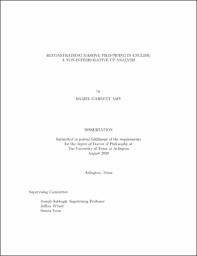
ATTENTION: The works hosted here are being migrated to a new repository that will consolidate resources, improve discoverability, and better show UTA's research impact on the global community. We will update authors as the migration progresses. Please see MavMatrix for more information.
Show simple item record
| dc.contributor.advisor | Sabbagh, Joseph | |
| dc.creator | Amy, Daniel Garrett | |
| dc.date.accessioned | 2020-09-09T20:55:23Z | |
| dc.date.available | 2020-09-09T20:55:23Z | |
| dc.date.created | 2020-08 | |
| dc.date.issued | 2020-09-04 | |
| dc.date.submitted | August 2020 | |
| dc.identifier.uri | http://hdl.handle.net/10106/29358 | |
| dc.description.abstract | This dissertation focuses on the distribution of "massive pied-piping" (Heck 2008) constructions in English. Compared to other forms of wh-movement and pied-piping, broadly speaking, massive pied-piping is limited in the environments in which it may occur. The primary goals of this dissertations are to examine (i) whether massive piped-piping is restricted to non-subordinated clauses (cf. wh-movement), (ii) what effect prosody has on relative clause interpretations, and (iii) how the distribution of massive pied-piping can be explained given a wider pattern of acceptability. To address these questions, I combine traditional syntactic and semantic judgments with two psycholinguistic experiments that utilize a context-continuation plausibility judgment paradigm during spoken language comprehension. The results of these formal diagnostics and psycholinguistic experiments suggest that massive pied-piping cannot be restricted based on the non-subordinated status of the clause hosting the movement, and I argue that massive pied-piping is restricted to non-interrogative clauses. To account for this new generalization, I present an analysis that combines a Q-based analysis of wh-movement (Cable 2010) with a two-stage, Focus/wh-Agreement process (Den Dikken 2003). While both interrogative and non-interrogative clauses can host simple wh-movement or pied-piping through QP-movement (motivated by Focus-agreement) under this analysis, massive pied-piping is disallowed in truly interrogative clauses as a result of an inability to establish a local Agreement relationship between the wh-features. In non-interrogative clauses, however, I argue that this relationship is never initiated due to an inherent lack of a wh-feature at the complementizer level; thereby, massive pied-piping is allowed to occur. In addition to accounting for the distribution of massive pied-piping, this analysis accounts for the unrestricted nature of simple wh-movement and forms of obligatory pied-piping without additional mechanisms. | |
| dc.format.mimetype | application/pdf | |
| dc.language.iso | en_US | |
| dc.subject | Syntax | |
| dc.subject | Sentence processing | |
| dc.subject | wh-movement | |
| dc.subject | Pied-piping | |
| dc.subject | Prosody | |
| dc.title | Reconstraining massive pied-piping in English: A non-interrogative CP analysis | |
| dc.type | Thesis | |
| dc.degree.department | Linguistics | |
| dc.degree.name | Doctor of Philosophy in Linguistics | |
| dc.date.updated | 2020-09-09T20:55:24Z | |
| thesis.degree.department | Linguistics | |
| thesis.degree.grantor | The University of Texas at Arlington | |
| thesis.degree.level | Doctoral | |
| thesis.degree.name | Doctor of Philosophy in Linguistics | |
| dc.type.material | text | |
| dc.creator.orcid | 0000-0001-8338-7850 | |
Files in this item
- Name:
- AMY-DISSERTATION-2020.pdf
- Size:
- 1.830Mb
- Format:
- PDF
This item appears in the following Collection(s)
Show simple item record


